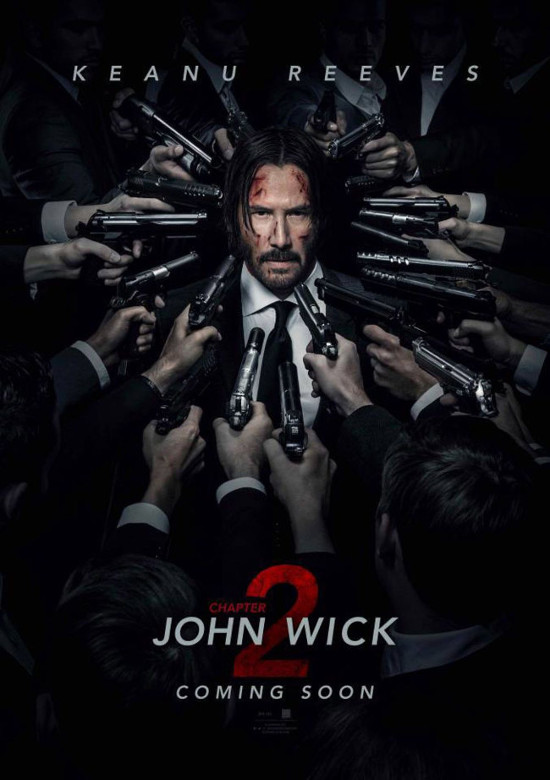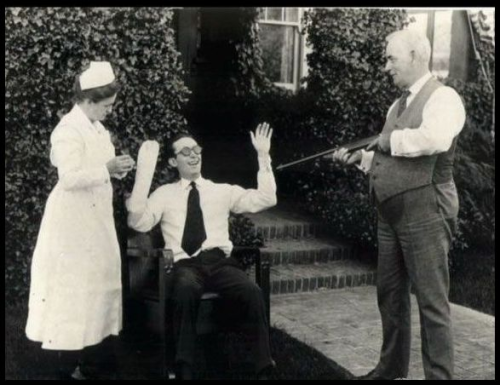An observation I am sure many of you have made over the years is the general stupidity (and lack of skill) the villains, police or any other nefarious enemy has had in the movies. With the James Bond films being a prime example, it shows the low standards the maniacal mastermind must have had when hiring his henchmen – they cannot shoot, drive or seemingly do anything else, stumbling over each other in the process. Also think of John Wick or any other motion picture made over the past multiple decades.
Well, it was this thought that struck me as I sat watching two early silent shorts from the comedic great Harold Lloyd (placed alongside Charlie Chaplin and Buster Keaton as the top comics of the silent era). Starting with 1919’s Bumping into Broadway, it was the first time the actor donned his now-famous “glasses” character, usually just referred to as The Boy. A two-reeler that lasts twenty-five minutes, it has The Boy getting into all kinds of hijinks.
A struggling playwright who barely has a pot to piss in, The Boy falls for his boarding house neighbour, The Girl (Bebe Daniels), an equally struggling actress, giving her his last few dollars so that she will not be evicted. . . but by doing so, finds himself without the money to pay his rent. Dipping, dodging and hiding from his persistent landlady (Helen Gilmore) and her muscle (Noah Young) – just the first of the obstacles in our protagonists way, he is successfully able to evade them and escape their confines. Just one example of their ineptitude, the landlady chastises her tenant from behind (seeing his straw hat and jacket), only to later realize that it is just a cleverly concocted stand-in using a wooden board and chair – I’d call it the Ferris Bueller, but since this movie is more than sixty years its junior, that just doesn’t work.
Meeting up with his crush time and time again, he eventually waits for her outside of the playhouse where she is working. The Girl is escorted out by a wealthy, slick player named Johnnie (William Gillespie), so he cleverly follows the pair to a high-class, illegal gambling den and bar. With luck on his side, The Boy is able to enter and win at roulette, only to have the police raid the place. Will he escape with The Girl and the money?
Met with fanfare and excellent reviews upon its release, it was Lloyd’s first film with Pathé Exchange production and distribution company; there was even more buzz upon its November 1919 release, as he had been seriously injured just a few months prior. Doing some promotional photos while holding a prop bomb, it actually exploded, causing the actor to lose a forefinger as well as his thumb. Also burning him and damaging his vision, he miraculously made a full recovery (minus the appendages), and with his new, popular character that brought with it much box office success, he continued on his destined path and became one of the cornerstones of the early comedic film era.
In 1920’s An Eastern Westerner, Lloyd’s Boy is a young New York playboy in the 1800s (we must at least assume so, as it announces in the credits that the time is “several thousand cocktails before the prohibition hour”), consistently out till the early hours of the morning at lavish parties. At his wit’s end, his very religious father sends him into the western wilds to work for his ranch-owning brother (hoping that there will be no temptations for him in this less civilized part of the country).
Though, it is called the wild west for a reason, and The Boy soon witnesses the raucous, violent, gun-toting nature of his sandy new home – never even reaching his uncle’s abode. Meeting a desperate young Girl (Mildred Davis – a frequent collaborator of Lloyd’s, they eventually married in 1923) with an ill father, she has been forced to work for the toughest hand in town, Tiger Lips Tompkins, aka The Bully (Noah Young) – who owns half of the county.
The ingenue’s father has been kidnapped by the monstrous man, a manipulative ploy that will force her to fall into his arms. Getting caught up in the middle of the dangerous shenanigans after showing off his lackluster skills (lassoing and jumping out of a window onto a horse) outside the saloon, The Boy, also infatuated with The Girl, decides to help her rescue her dear old dad.
After pulling off the daring rescue, the furious Bully rounds up his posse (that wear white hoods that come off like some kind of mix between a scarecrow and the KKK) and orders them to hunt down the troublemaker. Will The Boy be able to rescue his beloved and save the day?
Filming this one after the aforementioned accident, you will clearly observe that he is not doing too much with his right hand (the one that he injured during the photo shoot). Wearing a flesh coloured glove on it, in a key gambling scene, you will notice that most of the working action is done with the left hand. The maimed right one just holds the cards and is hidden below the table when not needed. Despite that, if not forewarned, you would be hard-pressed to notice anything out of the ordinary in Lloyd’s action packed performance.

This poster from ‘John Wick 2’ pays tribute to the promo shot of ‘An Eastern Westerner’ found up above – the film also pays homage to another silent comic, Buster Keaton
With both shorts ending with engaging action sequences, they are the highlights of both films (that is not saying that there are not multiple gems found throughout). The movies highlight the idiocy of the villains. Lloyd uses one of his famous manoeuvres in both – pulling himself up and holding his weight below a coat and drying laundry to evade the eye of his pursuers. Like a raucous cartoon, he entertainingly flips and dodges his foes, bashing them over the head when he can. At one point (while wearing a black sheet over his head), he swaps his disguise with a white costume-wearing enemy – convincing the bad guys to bash one of their own over the head with logs (as they now think it is The Boy). Fusing comedic timing with over-the-top action, both finales are superlative examples of the supreme motion and skills these early actors had.
Though not Lloyd’s best, they are wonderful early examples that feature him honing his iconic “glasses” character whilst demonstrating his skills and rich, fluid movement onscreen. Both Bumping into Broadway and An Eastern Westerner conclude with ingeniously designed climactic set pieces that are still quite the sight. Reiterating once again the entertainment value of watching the antagonists being outwitted by the hero, these early films started a trend that is still being used today. So, draw a ring around these two titles and roll out the red carpet for Harold Lloyd, you’ll fall in love, once again, with his genius.



